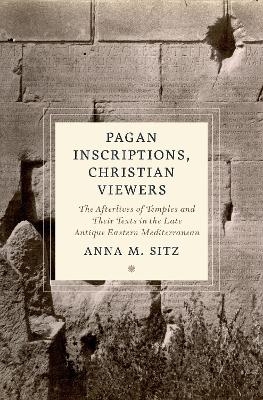
Pagan Inscriptions, Christian Viewers
Oxford University Press Inc (Verlag)
978-0-19-766643-2 (ISBN)
What did people in the early Christian period think about the pagan inscriptions filling their late antique cities? Like public advertisements lining our streets today, these inscriptions were everywhere and communicated specific messages to literate late Roman viewers, often providing a very different view of the classical past than that being preached from early Christian church pulpits. In Pagan Inscriptions, Christian Viewers, Anna M. Sitz provides a fresh perspective on the Christianization of the Roman empire from the fourth to the seventh century CE by analyzing a previously overlooked body of evidence: the many ancient, pagan inscriptions, written in Greek or other languages, which were reused, preserved, or even partially erased in this period.
This volume brings together for the first time the literary and archaeological evidence for attitudes towards these ancient inscriptions in the eastern Mediterranean, from Greece to Asia Minor, Syria to Egypt. Pagan Inscriptions, Christian Viewers illustrates how early Christians, late pagans, and Jews in the eastern Mediterranean interpreted older inscriptions in Greek and other languages through their own worldviews in order to build the late antique present.
Anna M. Sitz is a Postdoctoral Fellow at the Universität Heidelberg.
Chapter 1. Introduction: Afterlives of Inscriptions
Epigraphic Reincarnation at Megara
Manufactured Violence
Inscribed Sanctuaries
Literacy in Late Antiquity
Chapter Outline
The Fine Print
Chapter 2. The Use of Real or Imagined Inscriptions in Late Antique Literature
The "Arch of Alexander" and the Ends of the Earth
Writing the Past from Inscriptions
Prophesying from Stone: Invented Oracles
Plagiarizing for the Saints: The Life of Abercius
Conclusion: The Literary Afterlives of Ancient Inscriptions
Chapter 3. Preservation: Tolerating Temples and Their Texts
Touring Temples
Inscribed Text and Figural Imagery at Unconverted Temples
Secular or Sacred? Imperial Documents on Temples of Uncertain Use
Priests, Talking Columns, and Unreadable Texts at Christianized Temples
Conclusion: Kings of the Past on Display
Chapter 4. Spoliation: Integrating and Scrambling tions-Inscrip
(T)reading the Past: Epigraphic Spolia Underfoot
Constructing Churches with Inscribed Text
Epigraphic Spolia Elsewhere
Conclusion: Mixed Re-Views of Old Texts in New Buildings
Chapter 5. Erasure: [[Damnatio Memoriae]] or Conscious Uncoupling?
Unnaming the Gods
Violence Against Statues
Violence Against Inscriptions
Selective Erasures
Indiscriminate Erasure and Destruction
Conclusion: Epigraphic Unnamings and a Fresh Start
Chapter 6. Conclusion: Unepigraphic Readings
Reading at the Temple of Augustus in Ankara Once More
An Archaeology of Reading
Spolia: Breaking the Monolith
Word and Image: Inscriptions and Statues
Land, Men, and Gods
Epigraphy: A New Direction
Bibliography
| Erscheinungsdatum | 04.03.2023 |
|---|---|
| Reihe/Serie | Cultures of Reading in the Ancient Mediterranean |
| Zusatzinfo | 66 Illustrations |
| Verlagsort | New York |
| Sprache | englisch |
| Maße | 162 x 241 mm |
| Gewicht | 630 g |
| Themenwelt | Geschichte ► Allgemeine Geschichte ► Altertum / Antike |
| Geisteswissenschaften ► Religion / Theologie ► Weitere Religionen | |
| ISBN-10 | 0-19-766643-4 / 0197666434 |
| ISBN-13 | 978-0-19-766643-2 / 9780197666432 |
| Zustand | Neuware |
| Informationen gemäß Produktsicherheitsverordnung (GPSR) | |
| Haben Sie eine Frage zum Produkt? |
aus dem Bereich



